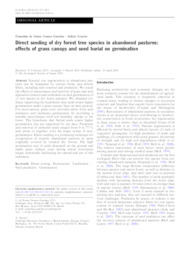Direct seeding of dry forest tree species in abandoned pastures: effects of grass canopy and seed burial on germination.
Direct seeding of dry forest tree species in abandoned pastures: effects of grass canopy and seed burial on germination.
Author(s): GUARINO, E. de S. G.; SCARIOT, A. O.
Summary: Natural tree regeneration in abandoned pastures can be hampered by various biotic and abiotic filters, including seed removal and predation. We tested the effects of maintenance and removal of grass and seed deposition (buried and unburied) on seed germination of 12 tree species in dry forest pastures. We obtained evidence supporting the hypothesis that seeds attain higher germination under a grass canopy than on bare ground. For most species, grass cover provides safety from seed predators and facilitates germination by providing a suitable microclimate with soil humidity similar to the forest. The hypothesis that buried seeds attain higher germination was not supported by our data. Predation and removal of unburied seeds ranged from 0 to 77 % and, alone or together, were the major causes of nongermination. Direct seeding is a promising technique for revegetation of recently abandoned pastures in areas originally covered by tropical dry forests. The high germination rate of seeds deposited on the ground and under grass reduces costs during initial restoration stages, potentially facilitating the spread and use of this technique.
Publication year: 2014
Types of publication: Journal article
Unit: Embrapa Acre
Keywords: Bosques secos, Cobertura do solo, Degradación de la tierra, Degradação do solo, Direct seeding, Direct sowing, Dry forests, Facilitation, Floresta, Floresta seca, Germinación de las semillas, Land degradation, Natural regeneration, Pastagem, Pastizales, Pastures, Poder germinativo, Regeneración natural, Regeneração natural, Restoration, Seed germination, Semeadura direta, Semente, Siembra directa
Observation
Some of Embrapa's publications are published as ePub files. To read them, use or download one of the following free software options to your computer or mobile device. Android: Google Play Books; IOS: iBooks; Windows and Linux: Calibre.
Access other publications
Access the Agricultural Research Database (BDPA) to consult Embrapa's full library collection and records.
Visit Embrapa Bookstore to purchase books and other publications sold by Embrapa.

